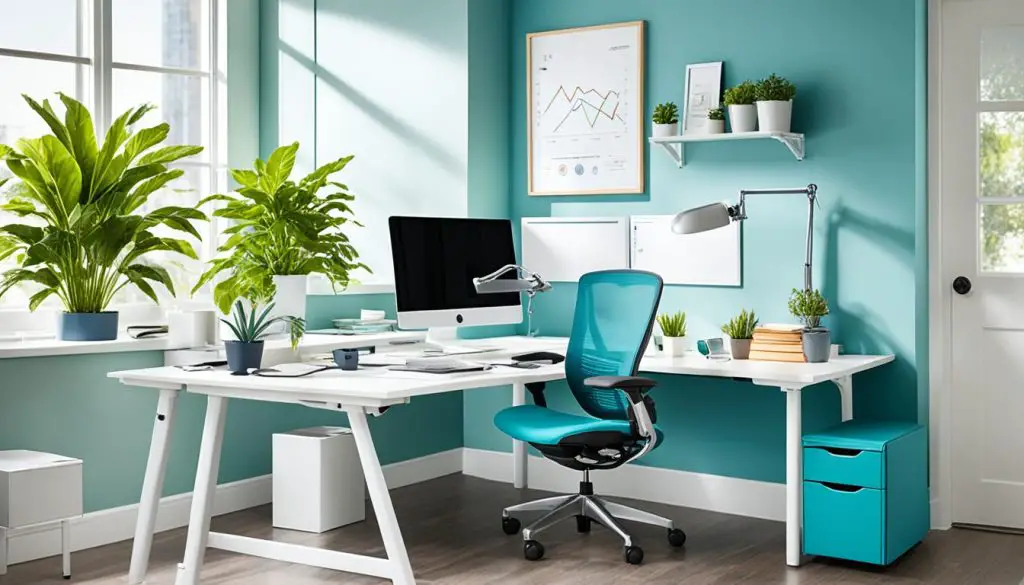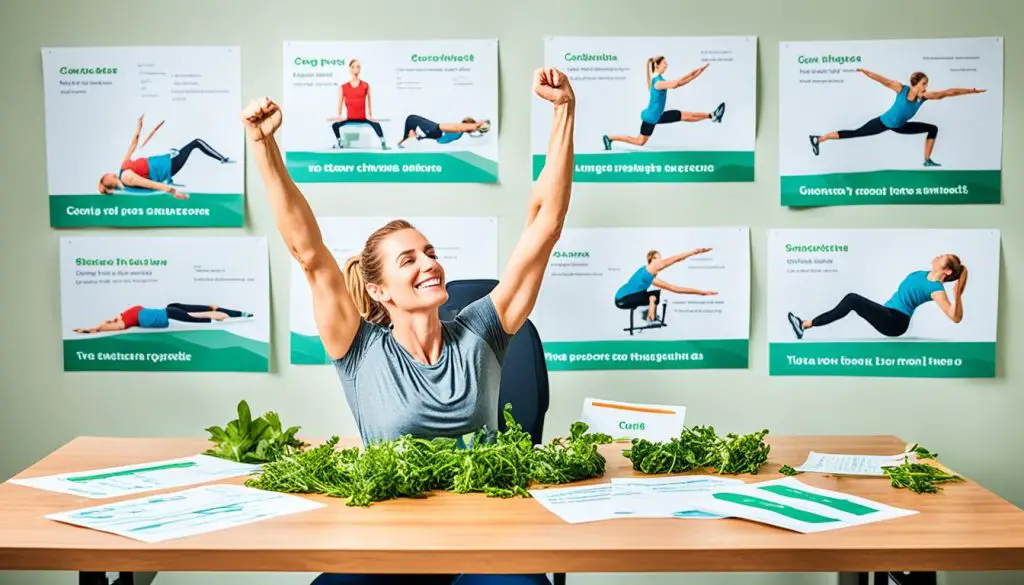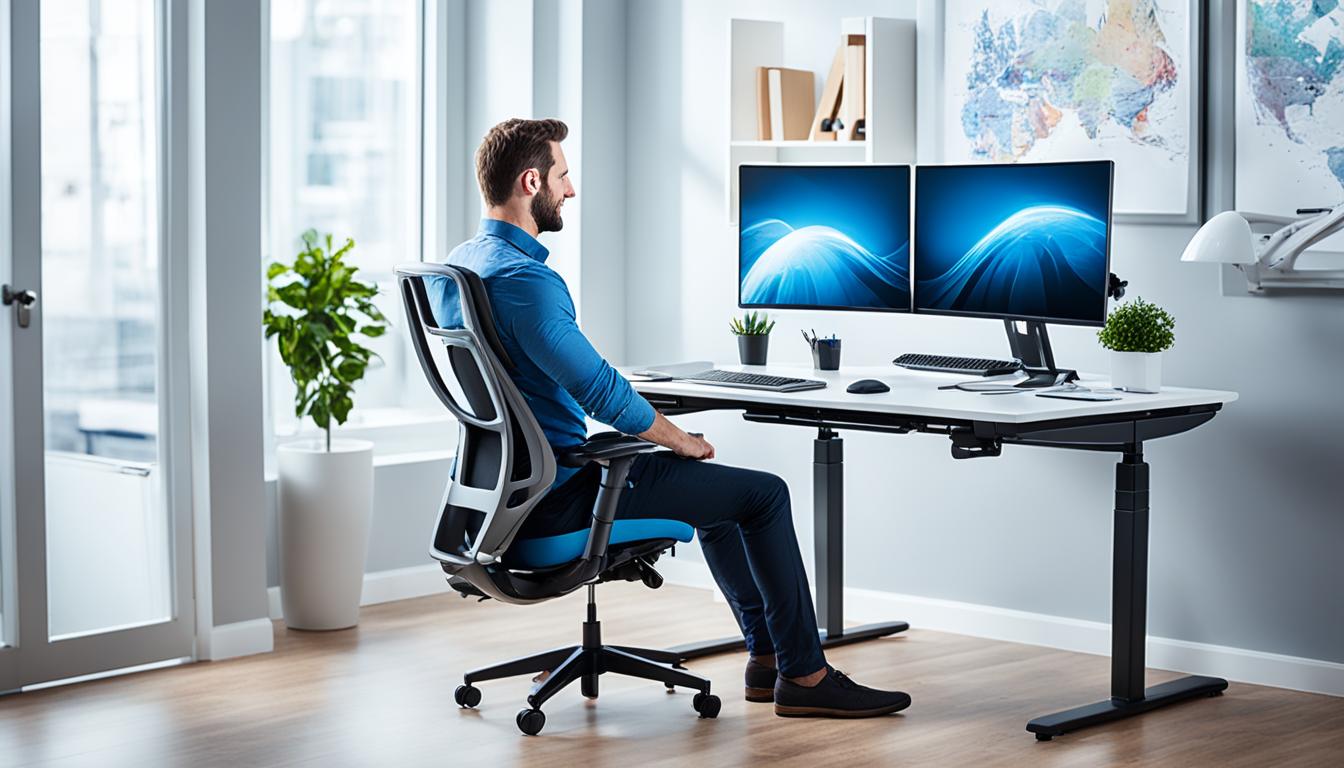Is your home office making your chronic pain worse? I’ve seen how much a good workspace can help. With the right furniture, lighting, and stress relief, you can make a space that feels great. This can reduce pain and make you more productive. Let’s look at how to design a workspace that makes you feel better and work better.
Learning from my wife’s journey with chronic pain, I see the value in creating a space just for her. We use chairs that fit her well and help her back, with materials that let her skin breathe1. Adding plants and light has a big impact too. The home office we’ve built supports both her body and mind. Her pain is less, and her work life is happier and more effective.
Setting up your home office right can really help, even if you’re not always working there. Think about adjustable desks or special mats for standing. There are many choices to make your space comfortable and help with chronic pain.1 If the pain gets too much, a quiet spot with a comfy chair lets you take a break. You can relax and get back to work without letting pain win.
Stop waiting and start changing your office for the better. A good design can really make a difference in how you feel and work. Together, we can find the best ways to decorate your office. This will help you fight pain and do your best every day.
The Pervasive Impact of Chronic Pain
Chronic pain affects many people globally and lowers their life quality.2 In the U.S., 20% of adults live with chronic pain, and 8% have it badly.2 It’s the top reason grown-ups visit the doctor.2 Illnesses like arthritis and neuropathy cause it through inflammation and nerve harm.3
Staggering Statistics on Chronic Pain Prevalence
Neck pain stops nearly 70% of people from doing their daily tasks.2 It impacts almost everything from feeling okay to really bad.2 Being active can lower tiredness and make sleeping better for those with chronic pain.2 It also lowers how much pain you might feel, stops muscle loss, and makes you feel happier.2 For tough cases like fibromyalgia, exercise is a good treatment.2 Doing activities like walking, easy sports, getting stronger, and stretching helps a lot.
This keeps you healthier and avoids big health issues like heart disease and diabetes.2
Economic Toll of Chronic Pain on Society
A study in the Journal of Pain says chronic pain costs America $560 to $635 billion a year.3 This includes money spent on healthcare, lost work time, and not being able to work.3 Treatments often use drugs, including strong painkillers.3 Physical therapy, with new ideas like using virtual reality, is key for managing the pain.3 Sometimes, surgeries are needed for really bad pain that won’t get better otherwise.3 Other helpful ways include acupuncture, chiropractors, and learning how to manage stress better.
Sources of Work-Related Chronic Pain
Work can bring on pain, especially for office workers. If you sit a lot at a desk, issues with your body can arise. These may stem from sitting wrong, standing too much, or staying still for a long time.
Not moving enough during the workday and doing the same actions over and over can also lead to pain. Changing your position when you feel stiff or taking short walks can really help.
Poor Posture at the Desk
Bad desk posture can cause pain in your neck, shoulders, and back. Keeping your spine well-supported while you work is key to avoiding chronic pain.
Prolonged Standing or Sitting
Staying still for long times puts pressure on your muscles and joints. This can lead to aches and pains. It’s important to take breaks and move around to prevent chronic pain.
Repetitive Strain Injuries
Doing the same work tasks again and again, like typing, can hurt your body. You might feel pain, stiff, or have trouble moving in the affected area.
| Statistic | Value |
|---|---|
| Percentage of adults in the U.S. who experience chronic pain | Approximately 20.4%4 |
| Percentage of adults in the U.S. who suffer from high-impact chronic pain | Around 8%4 |
| Annual cost of chronic pain to the U.S. economy | Between $560 billion and $635 billion4 |
Chiropractic Care for Work-Related Pain Relief
Chiropractic care is a strong way to ease work-related ongoing pain.4 At first, the chiropractor works to calm the patient. They say the pain isn’t from something serious. It should get better in a few weeks.5 They then start to help the patient feel less pain. This can be through simple medicine, cold or hot packs, light exercise, and advice on daily life activities.
Reassurance and Pain Management
In the beginning, the chiropractor’s main goal is to make the patient worry less. They explain the pain isn’t a big health risk. And, it should start getting better soon.5 This step is important because the patient starts to trust the treatment. It opens the door to using good pain management plans.
Manual Therapy and Gradual Activity Increase
After the comfort talk, they move to manual therapy. This hands-on method helps the patient feel less pain.5 Also, they slowly start increasing what the patient does each day. This ensures they safely go back to their normal work and life. It prevents their pain from getting worse.
Using a mix of chiropractic care, easing pain, and slowly upping activity helps a lot. It makes work-related pain better. And it brings back the patient’s ability to work and enjoy life.5
Yoga and Relaxation Techniques for Chronic Pain
Chronic pain affects many people and can be hard to deal with.6 Yoga and relaxation offer a way out. They help change how our body and mind respond to pain.6 This can lessen the impact of chronic pain. Specifically, relaxation is good for chronic pain because it reduces stress. This lets the body focus on healing, rather than feeling hurt all the time.6
Transforming Pain Responses to Healing Responses
Yoga teaches those with chronic pain to see it in a different light. By doing yoga moves, breathing exercises, and meditating, it eases the body and mind. It moves us from stress to relaxation. This change can make a big difference in how we feel pain, and how we handle it emotionally.6
Mindfulness and Breathing Exercises
Doing relaxations every day, like thanking and deep breaths, makes the body and mind feel safe, not always in danger.6 These methods can lower stress hormones and decrease inflammation. Both add to the feeling of chronic pain.6 Many studies show that relaxation can really help with pain management.6
Adding yoga, meditation, and other relaxing things to every day helps those with chronic pain feel better. It changes how they deal with pain, making their life better.6
Remedial Massage for Office-Based Stress Relief
Being an office worker means dealing with a lot of chronic pain. Through my experience, I found that remedial massage is a huge help.7 A lot of companies now offer chair massages for their staff. These are quick but do wonders to ease stress and soreness.7
The massage therapist uses special techniques. They apply more pressure and sometimes rub acros muscles through clothes. This reduces muscle tension, boosts blood flow, and helps move better – very important for people with chronic pain.8
Research backs up the benefits of massage therapy for managing pain.9 A study in 2004 showed how helpful massages are for chronic pain. Reviews in 2012 and 2014 highlighted the positive effect of various massages for back and shoulder pain.9 There are useful guidelines from groups like the Massage Therapy Body of Knowledge Task Force and the Coalition of National Massage Therapy Organizations too.9
I’ve personally seen the amazing impact remedial massage can have. It can break the pain circle, trigger the release of feel-good endorphins, and bring back a sense of comfort and joy.8 With the right moves and a skilled therapist, remedial massage can truly change the game for us office folks. It offers real help for handling chronic pain and stress.8
Home Office Decor Eases Chronic Pain
Buying high-quality, ergonomically designed office furniture like desks and chairs helps reduce staff’s chronic pain.10 Ergonomic chairs are made to provide great back comfort and support. They have special features like lumbar support and the right shape to help with posture. This leads to better comfort over time, lessening pain.10
Ergonomic Furniture: Key to Pain Relief
10 Office decor prices start from $25.00 to $8,950.00, but sales can drop up to 30% off.10 Items like ergonomic office furniture or zero gravity recliners cost more, ranging from $1,979.10 to $3,999.00. It shows the wide variety available. These items are focused on giving the best comfort and support, reducing chronic pain for those who work at home.
Adjustable Desks and Chairs for Optimal Posture
Having desks and chairs that can be adjusted help workers change how they sit or stand. This is key to handling and easing pain while working.10 Prices change over time, so it’s good to check for deals. By choosing ergonomic furniture and adjustable setups, employees can make a workspace at home that keeps their body aligned. This cuts down on the chance of getting chronic pain.

Wrist, Knee, and Back Support Gear
Creating a comfortable home office is key to fighting chronic pain. The right support gear is crucial. Wrist supports offer comfort and stability, reducing strain from typing or using a mouse.
Wrist Supports for Typing Comfort
Wrist supports keep hands in a safe place, stopping issues like carpal tunnel or tendinitis. They have soft padding and adjustable straps for the best comfort and movement during the day.
Knee Supports for Standing Desk Users
Knee supports are great for standing desk users. They keep knees in line, stopping strain and tiredness from standing a lot. These supports adjust and use breathable materials, making standing desks feel better.
Back Supports for Proper Spinal Alignment
Sitting too long can hurt our backs and make our posture bad. Back supports for chairs give the needed support for our lower back, keeping our spine right. They have many designs to fit different needs.10Using these supports in our home office helps with pain and makes us work better. They fight chronic pain and boost productivity. This way, our workspace is good for our health.
Importance of Regular Movement and Breaks
To fight chronic pain, it’s key to move regularly and take breaks at home. A study showed that being active, including just daily steps, cuts down on neck and back pain for people who sit a lot.11 Also, research tells us that breaks help lower back pain and boost work performance for office workers, according to both randomized and non-randomized trials.11 So, stepping away from our desks for a bit, doing light stretches or walking can improve both our bodies and minds.
Studies show that taking short microbreaks from computer work can lower discomfort.11 Another study found that planned breaks can prevent sudden back pain for those who sit a lot.11 Adding these quick breaks to our days helps us fight off the pains from working at home too much.
Research also reveals that how our seats and desks are set up can change how we feel and sit at work.11 Plus, there’s a plan to help stop muscle and bone issues at work by being careful about how our workspaces are arranged.11 Spending time to move and change where we work overcomes the bad effects of sitting too long and makes us feel better overall.
There’s evidence that cutting down on sitting at work can lower pains in muscles and joints.11 Following these easy tips to keep moving and taking breaks while working from home can really help in the battle against chronic pain.
Creating a Soothing, Low-Stress Environment
Working in a calming home office can ease chronic pain. Natural lighting and plants help make the space serene.12 They create a peaceful mood.
A tidy workspace also brings calm.12 Studies at Decoist.com found a clutter-free desk boosts peace. Plus, natural light cuts down on headaches and eyes strain.12 This makes the home office a more soothing place.
Stress-Reducing Colors and Decor
Choosing calming colors and decor can lower stress.12 Earthy colors like white, grey, and light blue foster peace. They also lift mood and help focus.
Adding plants like spider plants and bonsais can make the air better.12 They add a serene touch. Being in a quiet area helps, too.12 Creating a noise-free zone is good for focus.
Having a spot for meditation can make work better.12 It boosts your brain and helps you relax briefly. This leads to more work done with less stress.
Preventing Chronic Pain with Ergonomic Design
Ergonomic office furniture is vital for stopping and easing chronic pain. It’s made to match the curve of your spine. This prevents stooping and lowers stress on your back and hips. The lower back area carries a lot of weight and is easily hurt. So, a chair that fits the back’s curve helps ease strain. This gives your lower back muscles the support they need. It makes for better posture and more comfort.13
Lumbar Support and Improved Posture
Getting alignment right is crucial for comfort and lessening pain. Special ergonomic chairs work with the natural line of your spine. They offer the lumbar support needed for less pressure on your lower back.13 This setup leads to proper posture. It keeps your spine in a straight position and cuts muscle and joint stress.13
Proper Alignment for Optimal Comfort
Besides supporting your lower back, ergonomic office furniture encourages the right alignment for your whole body. Desks and chairs that can be adjusted let you find the best spot. This helps you stay in a good, upright position all day.13 It stops strain on your back, neck, and shoulders. This leads to a workday that’s less about experiencing pain.13
Training and Education for Safe Work Practices
Teaching employees is key for safe work habits and lessening work-related chronic pain.14 This training helps them spot and handle risky situations, making it easier to protect their health.
Company Policies and Procedures
Firm rules and guidelines are crucial for a safe work culture.14 They should explain what the company expects and how to keep workspaces comfortable and safe. By making these rules clear, employers ensure everyone helps keep the workplace healthy.
Leading by Example
Showcasing safe practices is a strong leadership move.14 When managers and supervisors practice what they preach, it inspires others to do the same. This builds trust and shows everyone is responsible for a safe workplace, cutting down on chronic pain risks.
Training, clear rules, and leading by example lead to a work setting focused on well-being.14 This approach decreases chronic pain from work, making a more health-focused, productive team.
Desk Stretches for Aches and Pains Relief
The coronavirus has many working from home for a long time now. This leads to more body aches because of less moving around15. Doing simple stretches and exercises at your desk can help remove this ache. It’s good to stretch every three hours. This boosts blood flow and makes your muscles feel less tight15.
Neck Strengthening Exercises
The chin tuck is great for neck pain. It makes your posture better and stops pain in your neck and shoulders15.
Mid-Back and Lower Back Stretches
Try seated cat-cow exercises for your upper back. They help your spine move better and reduce strain15. Standing up and reaching to the side can stretch your lower back. This feels really good, especially if you hold onto something like a door frame15.
Glute and Piriformis Releases
Loosening your glutes helps a lot with back pain from sitting all day. Massaging the piriformis muscle with a ball can release this tightness. It also makes moving easier15. Doing the “Hinge” exercise helps make your hips and butt stronger. Aim for 3 sets of 10 reps every day15.
Adding these desk stretches to your day can really help with pain. They’re great for when you sit for a long time and don’t move much. Always pay attention to how your body feels. If any pain lasts, talk to a doctor or a health expert.

Investing in Employee Well-Being
Being an employer, I strongly believe in caring for my workers. It’s not just the ethical choice but also smart for business. When I make sure my team is comfortable and healthy, they work better and enjoy their jobs more. This also helps lower the personal and social costs of dealing with chronic pain.4
About 20.4% of American adults face chronic pain. Nearly 8% battle with severe chronic pain.4 This health issue hits our economy hard, costing anywhere between $560 billion and $635 billion annually. This includes medical bills, lost work time, and disability costs.4 Tackling this problem means not just helping my team, but doing good for everyone.
My approach to boosting my team’s health includes using ergonomic furniture. This kind of furniture, like adjustable desks and chairs, can reduce chronic pain. I’ve also introduced relaxing activities like chair massages to give my employees a break.4 Education on how to work safely is also a key part. It gives my team the tools they need to keep both their body and mind in good shape.16
Creating a workplace that focuses on well-being has many benefits. It makes my team more productive and happier. This way, I’m helping build a better future for my company and my workers. A strong and healthy team is essential for our success.
Source Links
- https://apnews.com/buyline-shopping/article/best-office-chair-for-back-pain
- https://extension.usu.edu/heart/research/exercise-and-chronic-pain
- https://physiciansgroupllc.com/chronic-pain-management-innovative-therapies/
- https://desky.com/blogs/news/expert-ways-to-reduce-work-related-chronic-pain
- https://healthfitchiro.com/blog/chiropractic-to-treat-pain-from-a-poorly-designed-workstation
- https://www.ncbi.nlm.nih.gov/pmc/articles/PMC8405991/
- https://clinicsense.com/blog/designing-massage-therapy-treatment-plan-examples
- https://www.manchesterphysio.co.uk/treatments/massage/when-massage-can-help/chronic-pain.php
- https://www.ncbi.nlm.nih.gov/pmc/articles/PMC4925170/
- https://relaxtheback.com/
- https://www.ncbi.nlm.nih.gov/pmc/articles/PMC8091075/
- https://www.bayouclosets.com/how-to-design-tranquil-home-office
- https://www.alloffice.co.za/blog/ease-back-pain-ergonomic-desks-chairs/
- https://www.osha.gov/ergonomics
- https://www.shape.com/lifestyle/mind-and-body/working-from-home-desk-stretches-aches-and-pains
- https://dallasaccidentandinjuryrehab.com/ergonomics-and-pain-prevention-strategies-for-a-healthier-workplace/
